Facebook advertising is a powerful tool for authors and publishers looking to reach their readers and sell more books. With its advanced audience targeting capabilities, Facebook allows you to pinpoint your ideal readers with remarkable precision. This article is designed for those who have some experience with Facebook ads and are looking to refine their strategies to achieve better results.
Recent studies by Statista (statista.com) highlight the vast potential of Facebook, which boasts an estimated 250 million users. Breaking this down further:
- 24.2% are in the 25-34 age group
- 18.6% are in the 18-24 age group
- 11.7% are in the 55-64 age group
Given the platform’s extensive reach, even niche markets can consist of millions of potential readers. For example, there are 29.25 million users aged 55-64.
However, navigating Facebook’s sophisticated advertising landscape requires some know-how. This article will provide you with practical tips and techniques to optimize your book marketing efforts on Facebook. If you’re new to Facebook ads, I recommend starting with some foundational training. Here are a few free resources to get you started:
In the following sections, we’ll explore how to effectively use Facebook’s advertising tools to reach readers at different stages of the marketing funnel, from cold leads to enthusiastic fans. Whether you’re just starting or looking to fine-tune your approach, these strategies will help you leverage Facebook advertising to boost your book sales.
The Book Sales Marketing Funnel
The way we use this funnel breaks into four main categories: cold, warm, hot, and super hot.
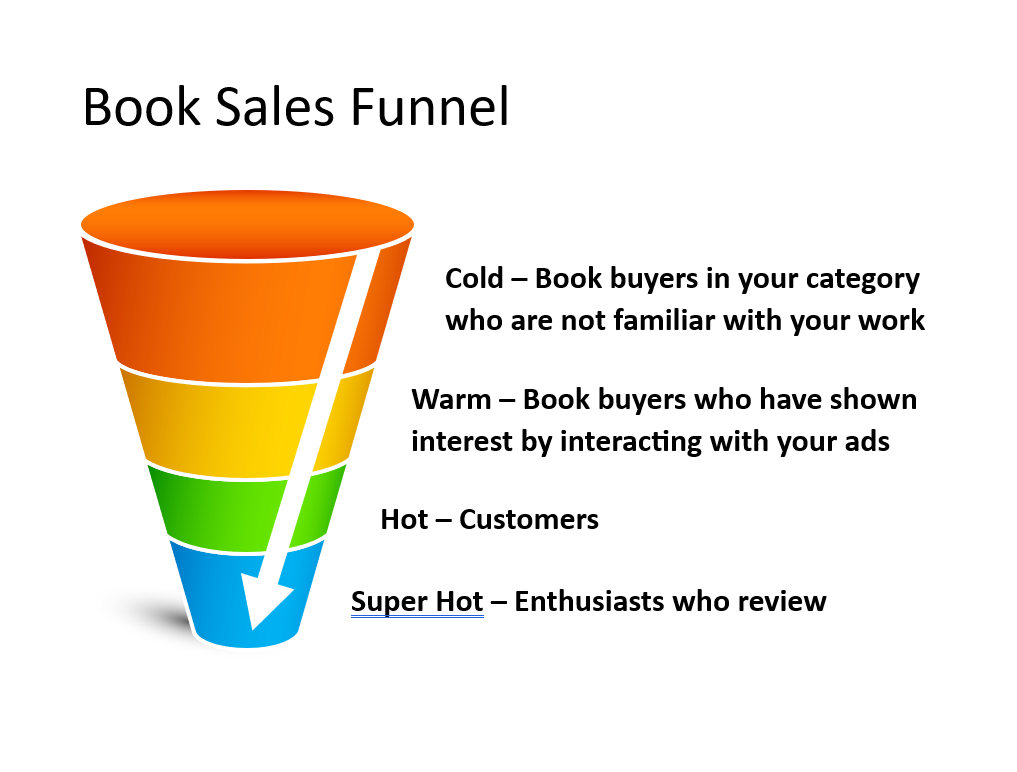
We address each of these stages of the funnel very differently on Facebook.
If you are just getting started, your focus will be on reaching new readers at the top stage.
I will walk you through some examples of how we use Facebook to promote to readers at each point of the funnel and the tools Facebook provides to make this possible.
Audience Settings on Facebook
You can highly target when doing marketing on Facebook. Create your audience by selecting the location, age, and interests of those who are most likely to benefit from your book. For instance, if you know where your book is likely to sell, you can pick the cities or states you want your ad to show:
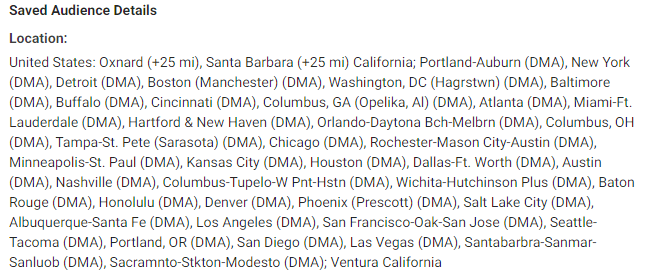
The image that follows is an example of a Facebook audience set up to reach people interested in sci-fi and fantasy authors. You can use two layers of audience targeting. I suggest targeting readers in the first section and the type of interest in the second section.
For example, if you are linking to a Kindle edition of your book, you can target Kindle device owners or people who have added Amazon Kindle on their page. Then, to further narrow down the target (the second level of targeting), select the authors, subjects, or genres your readers would likely be interested in. This way, Facebook will only show your ad to readers in a specific field of interest.

To help you find potential interests, type in authors of similar books or enter the subject matter or genre into the interest field, then click on “suggestions.” A dropdown box with possible interests and authors will appear. Then select the ones that are best for your potential reader:
Cold Stage of the Funnel
The first type of ads will test the possible artwork for your future ads. Testing images on Facebook is great because you will discover which ones are most effective while generating sales and engagement with new readers.
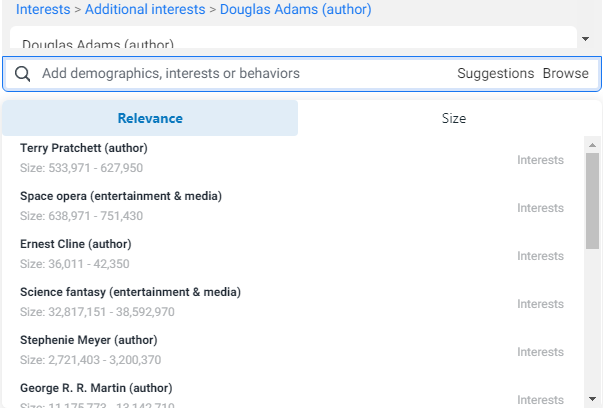
1. Select five images that best present your book and will interest readers. Images may have your book cover on a background of some kind, perhaps someone reading your book, or a scene inspired by your book. Follow Facebook’s guidelines for image sizes. Use the same text in the ad for each different image—only the image is different. Possibly use the blurb from your Amazon page.
2. Create a “Traffic” campaign. Build the ad set specifying the audience as above, and then create one ad for each image. Use the “Shop Now” button and link to the retailer where you want readers to buy. Make at least five ads—one for each image. Once you have created the first ad, you can duplicate it, change out the picture, and rename it. (Use a name that will help you quickly analyze what is happening while the campaign runs.)
3. Create an “Engagement” campaign. Use the same ad set targeting you used above, then build another ad for each of your image ad posts. This campaign will test which image is the most effective based on engagement.
For the ad setup, select “Use Existing Post,” and for the ad creative enter the post ID for the image ad you created for the traffic campaign in the previous step. (The post ID is in the post URL starting with “pfbid” followed by numbers and symbols.) Once you have the first one published, duplicate it to create the next one and add in the correct post ID. Do this for all five image ads.
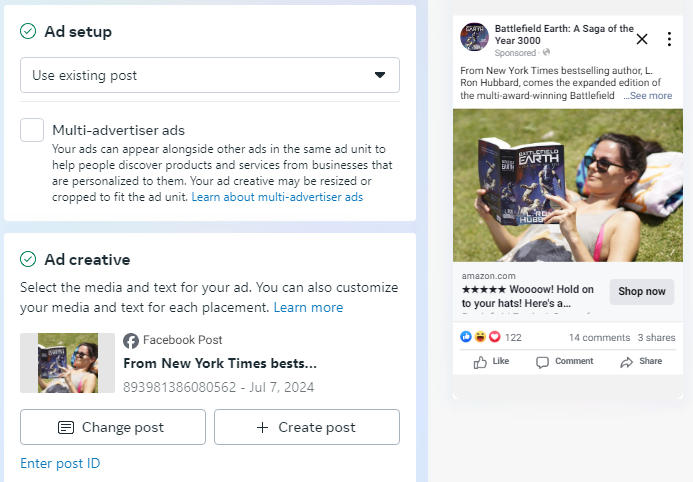
4. Once you set up the five engagement ads, set a rule to stop the ad once it has 1,500 impressions. This rule will ensure that the same volume of impressions is shown for each ad.
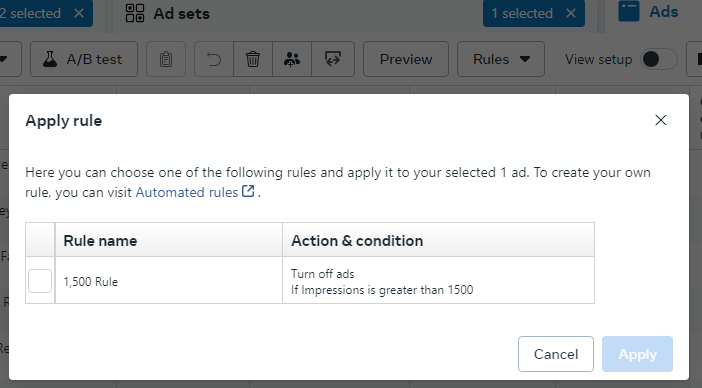
5. Pick the most effective art once your test is complete. This should be the one with the lowest cost per engagement, lowest cost per outbound click, and highest click-through rate (CTR, which, for an ad like this, counts the engagement and outbound links together for the ratio against impressions). The speed of the test will vary depending on your budget.
6. Using the winning artwork, repeat these steps using five versions of your copy and headline to find the most effective copy.
7. Start testing different audience using the combination of the winning artwork and copy.
The ad will be the same in this case, but the target audience at the ad set level will be different. You will create a different ad set for each audience you test (one for each author or area of interest). Start with one ad set and ad, and once it’s published, duplicate it. Change the audience and publish. Repeat for each audience you want to test.
At the cold stage of the funnel, constantly test new images, copy, and audiences. Not only will you be selling, but you will also develop an interest in your book, which will help at the next stage of the funnel.
Warm Stage of the Funnel
1. Go into the audience section of the Facebook Ad Manager dashboard and create an audience of people who have engaged with your page over the last 365 days.
Here is an example:
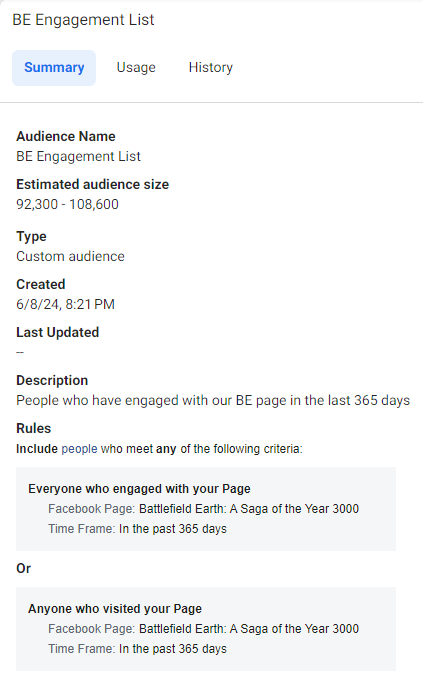
2. Launch a “Traffic” campaign and ad to this audience to sell your book. As these readers have already interacted with your page, a higher percentage will be ready to buy when they see your ad.
3. Conditional: Launch an “Engagement” campaign that uses this post to improve social interactions. Facebook rewards posts with interaction, which should reduce your overall cost per outbound click on the traffic ad. (See step 3 in the previous section for how to do this.)

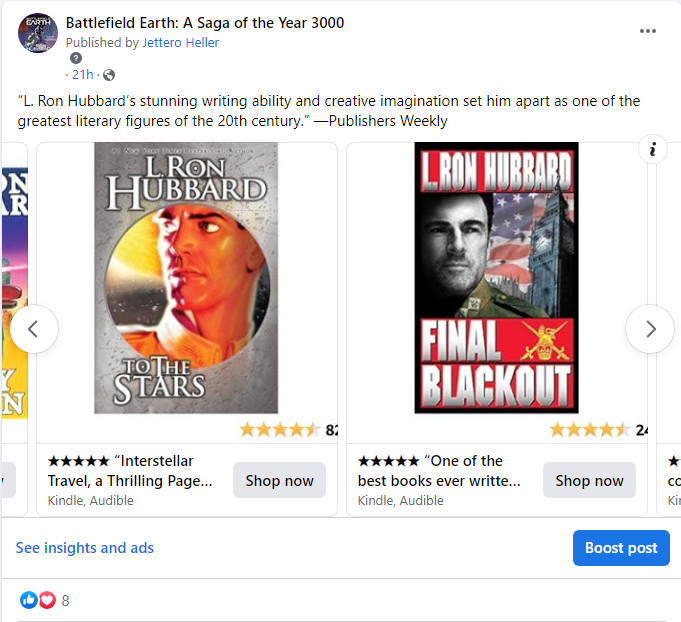
4. Running a discount special? Create a Facebook ad promoting it to this audience.
5. Create a “Lead Generation” campaign and ad to build your mailing list. Offer an incentive for signing up (perhaps the first book in a series, the first chapters of your book, etc.). This ad will target your page engagement audience to opt-in for your mailing list. Note: If your offer is a PDF, you can upload it directly in the Facebook form; if not, you can add a link to access your offer.
Hot Stage of the Funnel
1. Go into the audience section of the Facebook Ad Manager dashboard and create a custom list using your mailing list.
2. Create a “Traffic” campaign for your backlist titles and box sets, using this audience at the ad set level.
3. Build a carousel ad within this campaign that selects each backlist or box set into one ad.
4. At the same time, using your mailing/customer list as the audience, create another ad offering an advance reading copy of your next book. You can use the “Lead Generation” campaign function for this, which will accumulate your hottest fans—the enthusiasts who will not only buy your books but also help you promote them.
Super Hot Stage of the Funnel: Enthusiasts
1. Upload the signups for your advance reading team as an audience.
2. Many of these readers will already be in your mailing list audience and, therefore, seeing your backlist ads. You can invite this audience to a Facebook fan group, send them messages and videos using Facebook ads requesting them to review their favorite book, etc.
3. Occasionally, offer these readers bonus content to keep them engaged.
4. Offer them the first access to your early review copies.
Summary
Knowing your funnel can move readers from being unaware of your book(s) to becoming enthusiasts. We usually spend about 30% of our marketing budget on Facebook, and of that, we spend 30% on new (cold) readers, 40% on warm readers engaging with our pages, 20% on hot readers, and 10% on our super hot readers to keep them engaged.
I highly recommend signing up for the Self Publishing Formula’s “Advertising for Authors” course. It covers the above strategy in detail with videos every step of the way. Mark Dawson and his partner James Blatch also include several other marketing courses in their training program. It is only open to register twice a year, so keep an eye open for it in fall 2024: learn.selfpublishingformula.com/p/adsforauthors.
Good luck, and sell many books!
Juliet Wills is the vice president of sales and rights at Galaxy Press.